Abstract
More than 30 different methods have been used to assess physical activity. These methods can be grouped into seven major categories: calorimetry, job classification, survey procedures, physiological markers, behavioral observation, mechanical and electronic monitors, and dietary measures. No single instrument fulfills the criteria of being valid, reliable, and practical while not affecting behavior. The instruments that are very precise tend to be impractical on a population basis. Surveys are the most practical approach in large-scale studies, although little is known about their reliability and validity. Studies employing objective monitoring through heart rate, movement sensors, and doubly labeled water procedures appear promising, but are still experimental and costly. Despite the difficulty of measurement, relatively strong association has been found between physical activity and health, suggesting that, with improvements in assessment techniques, even stronger associations should be seen.
Full text
PDF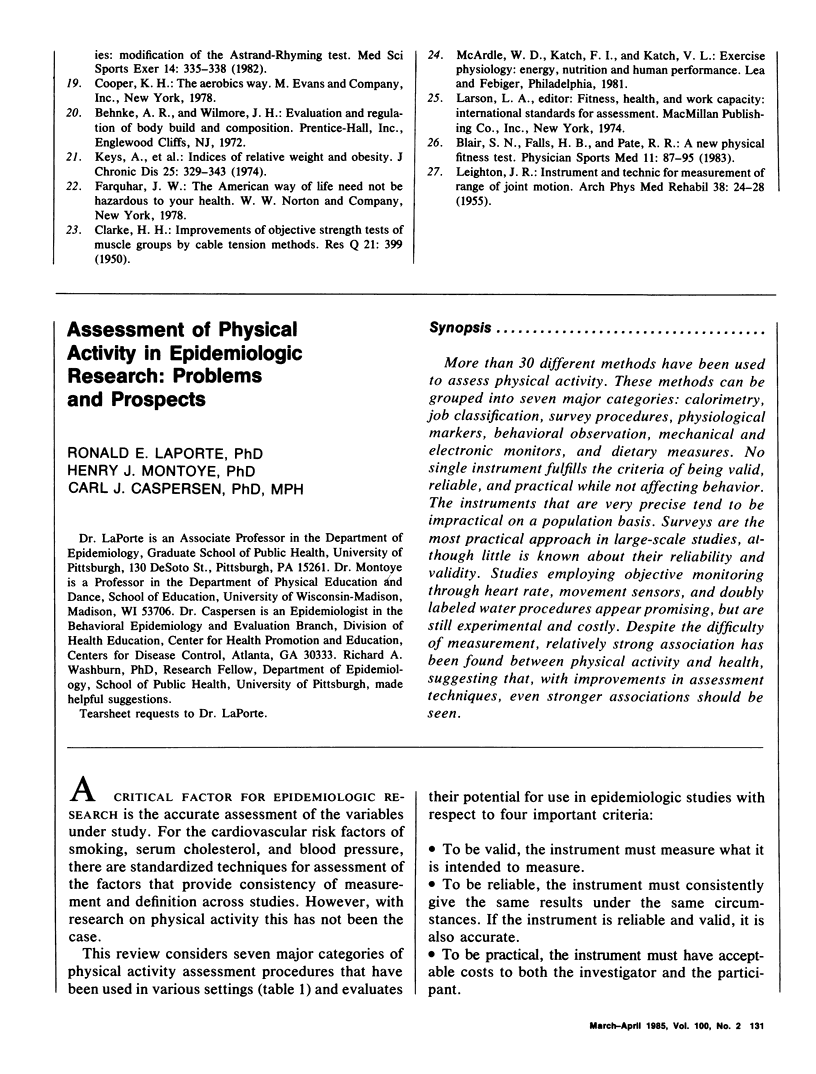
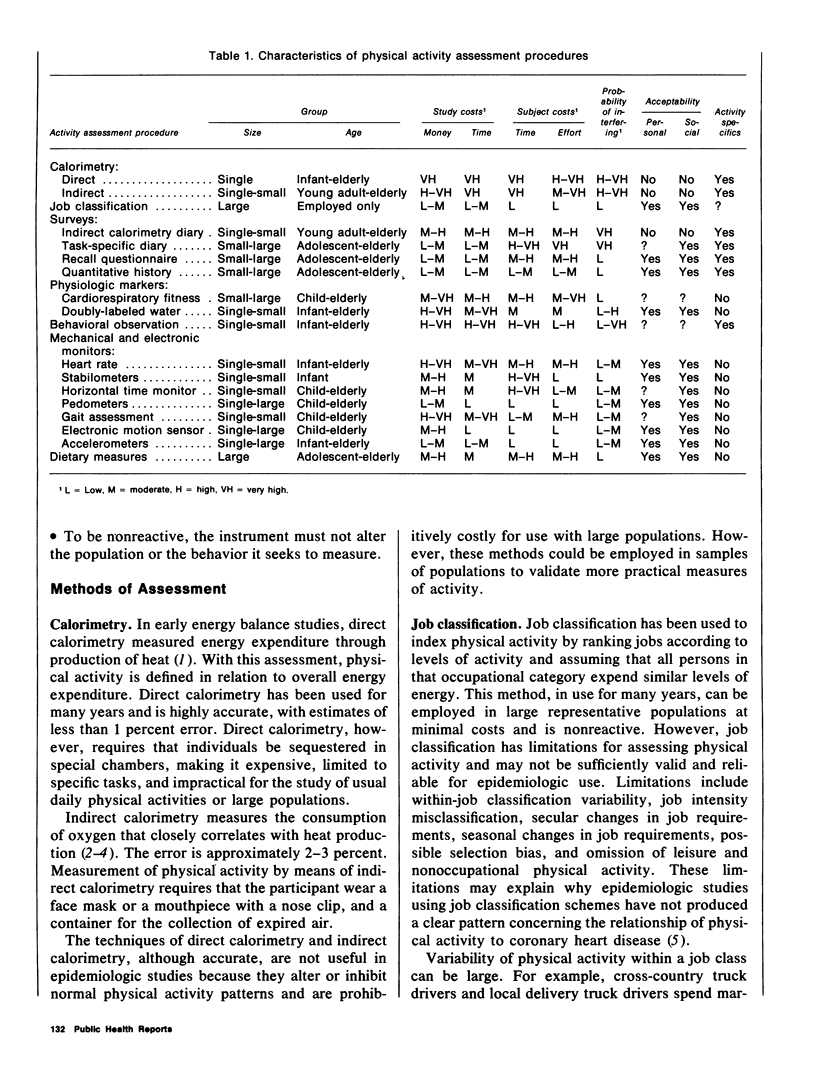
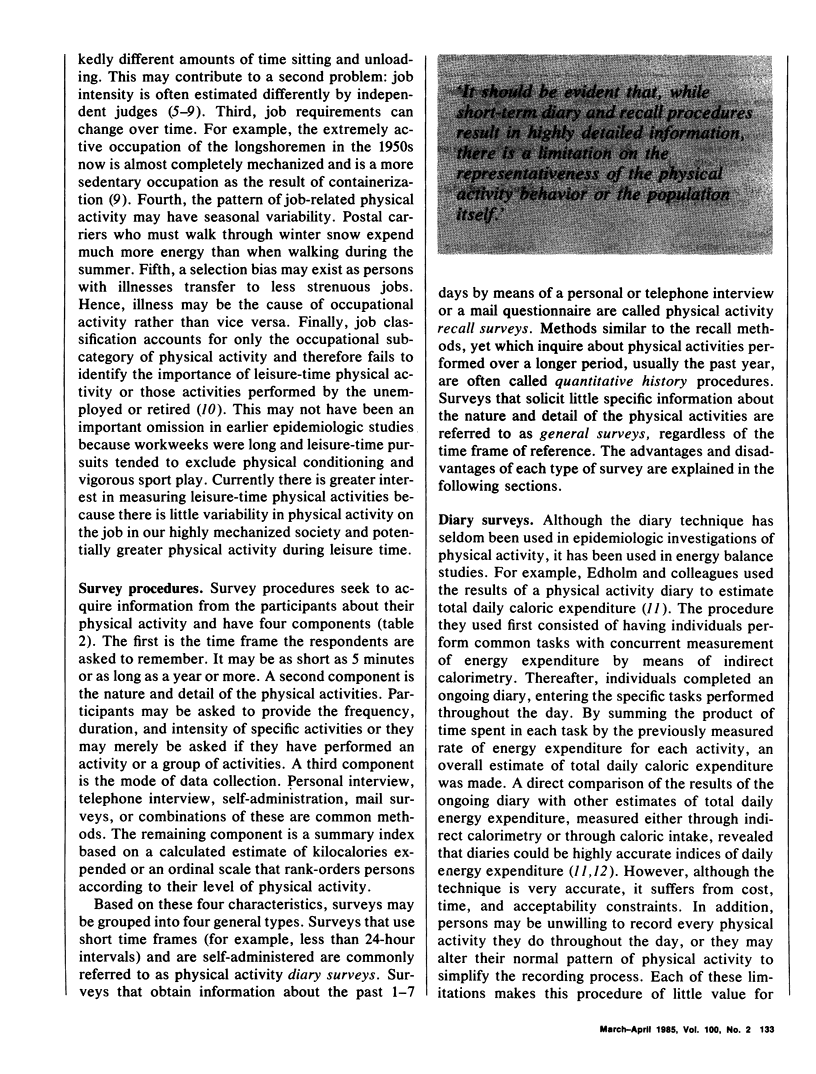
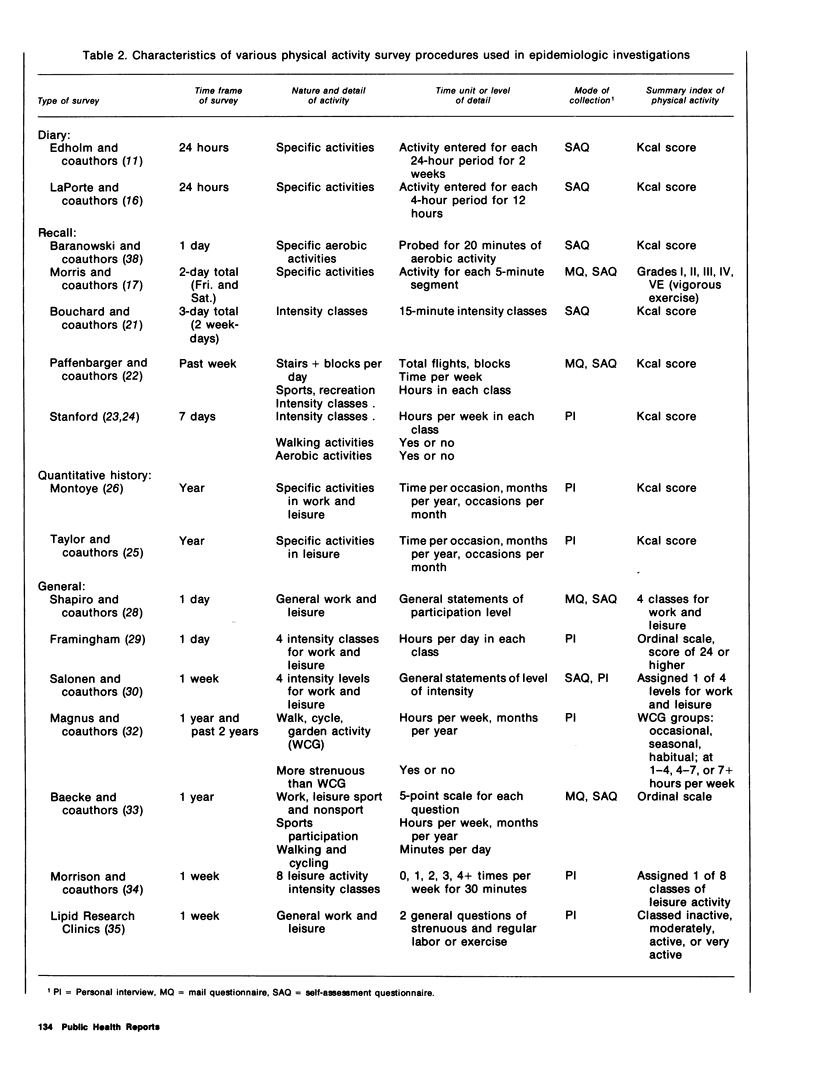
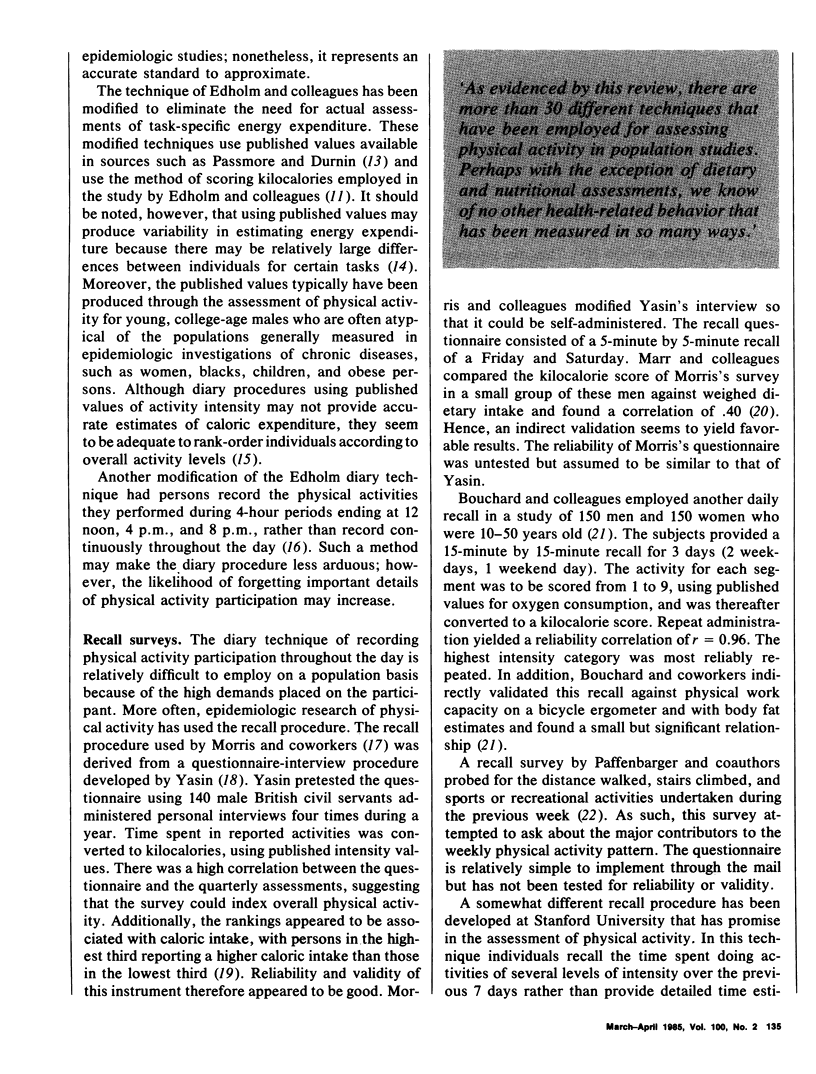
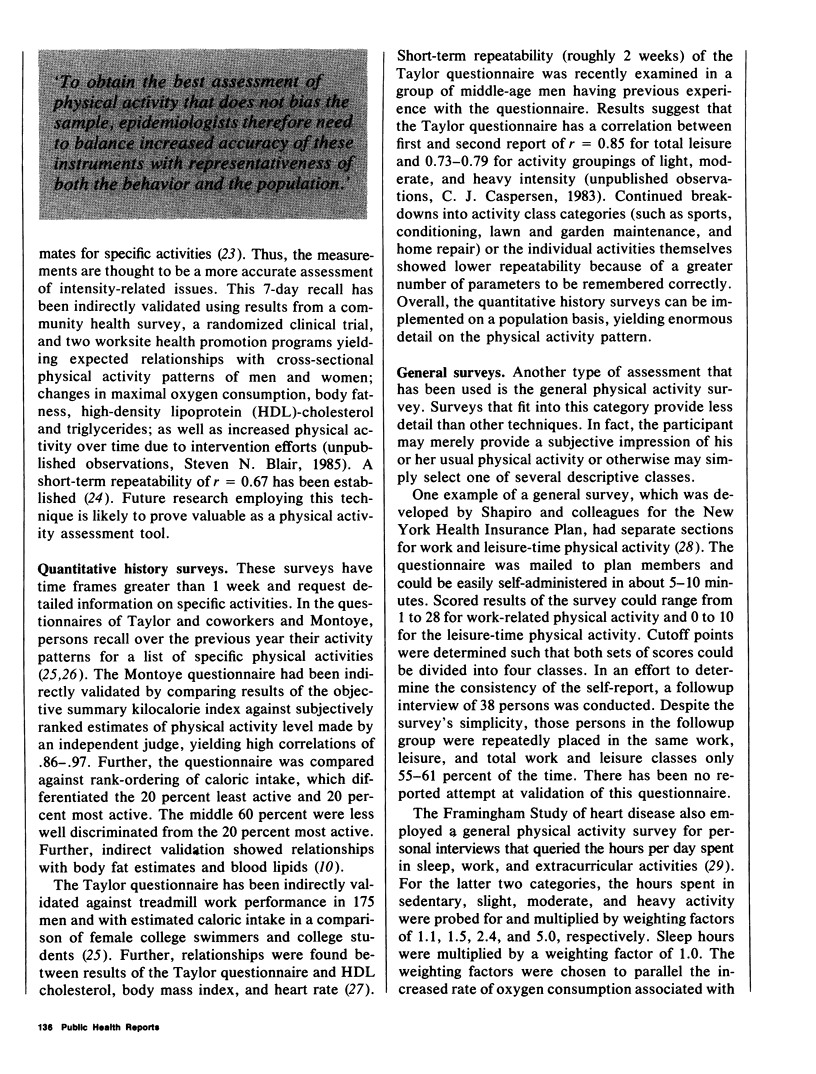
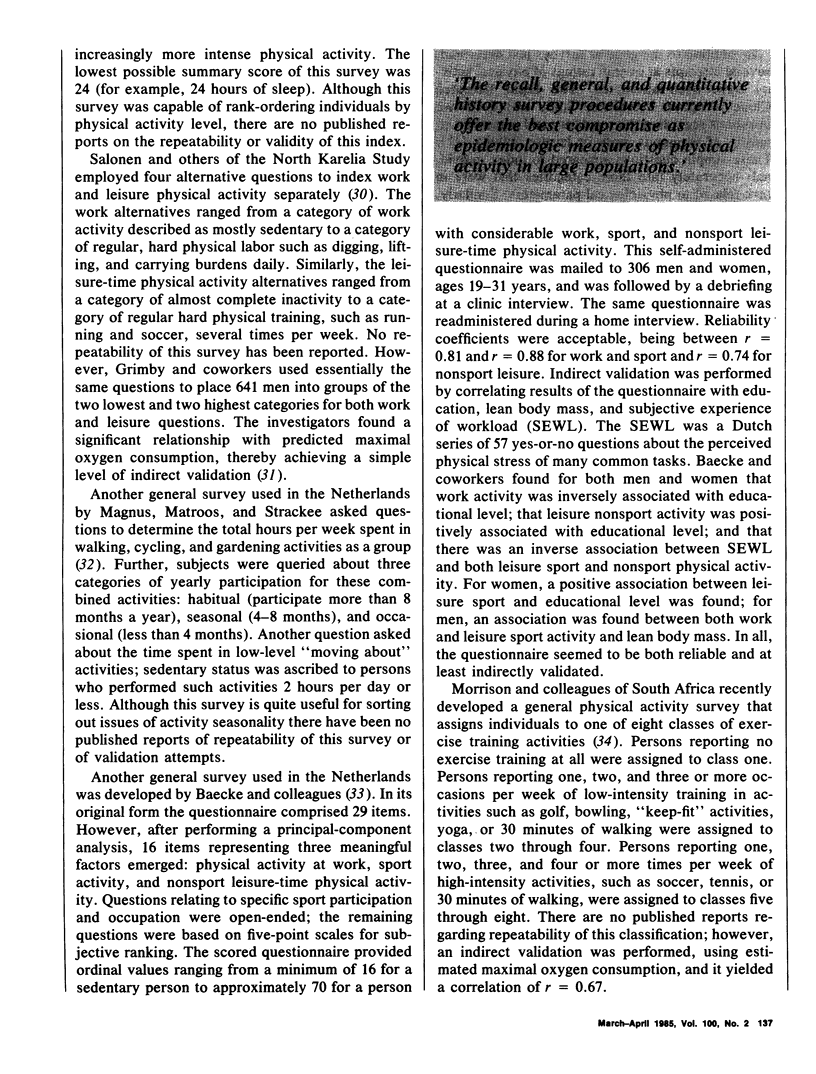
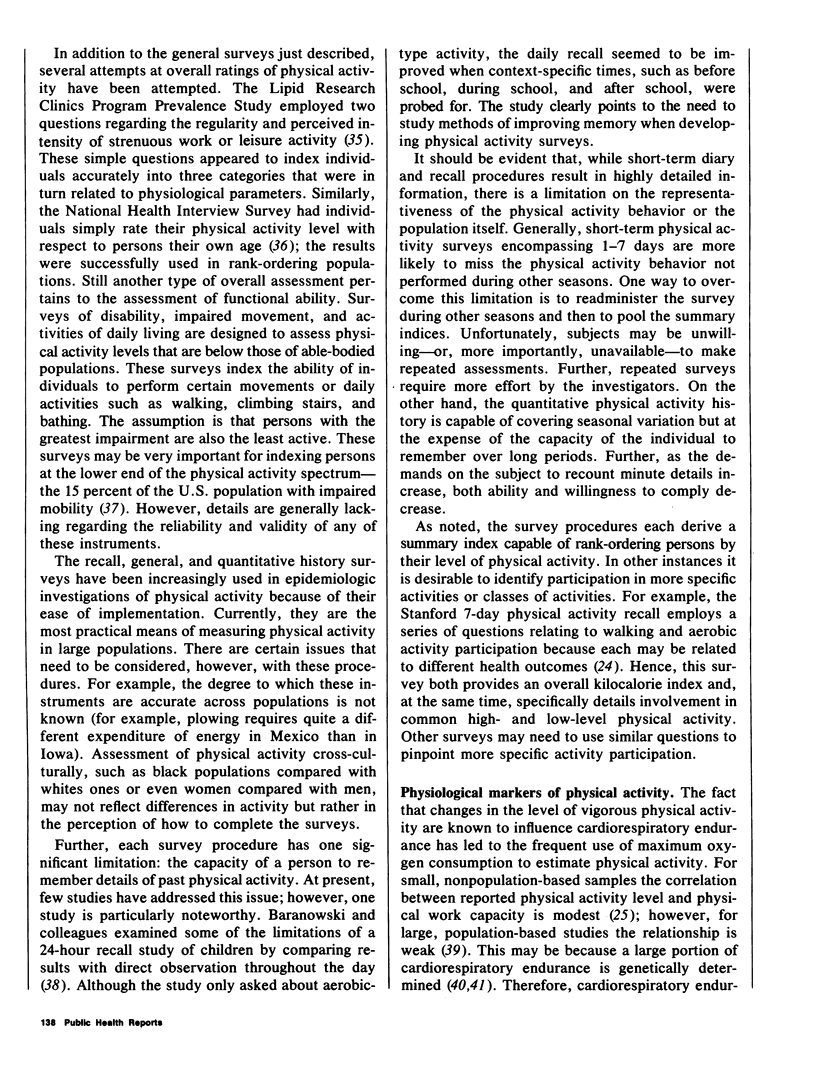
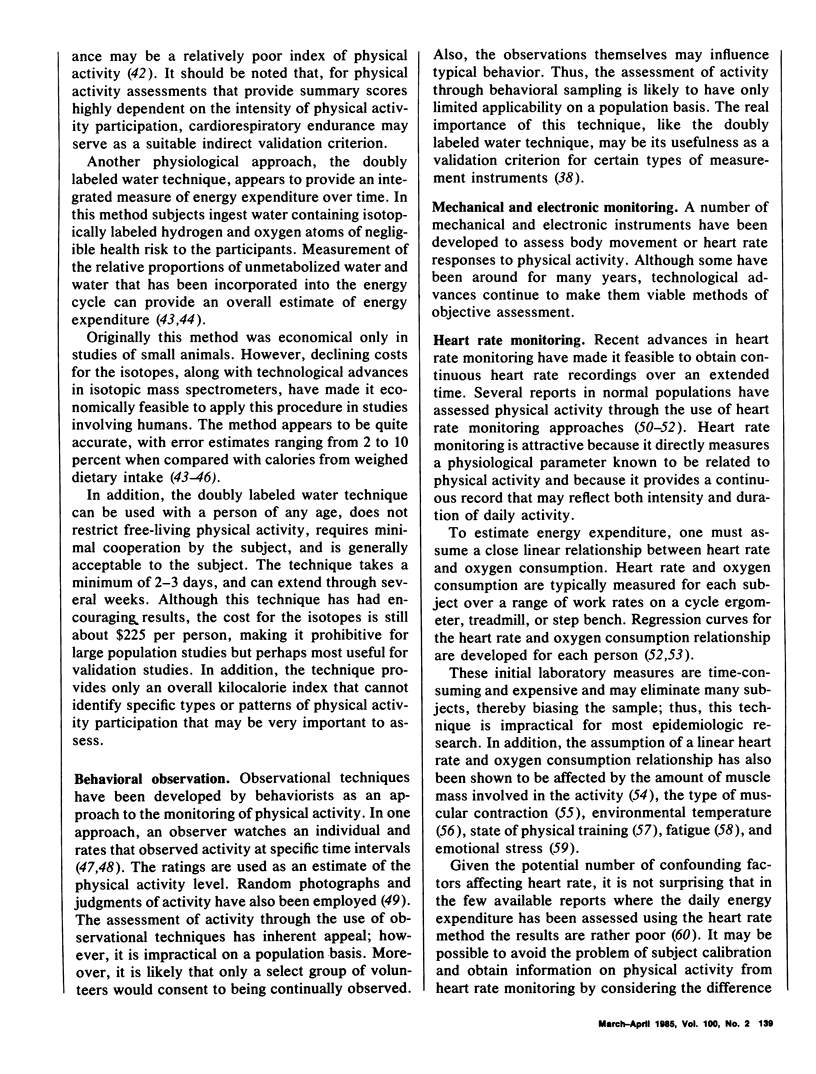
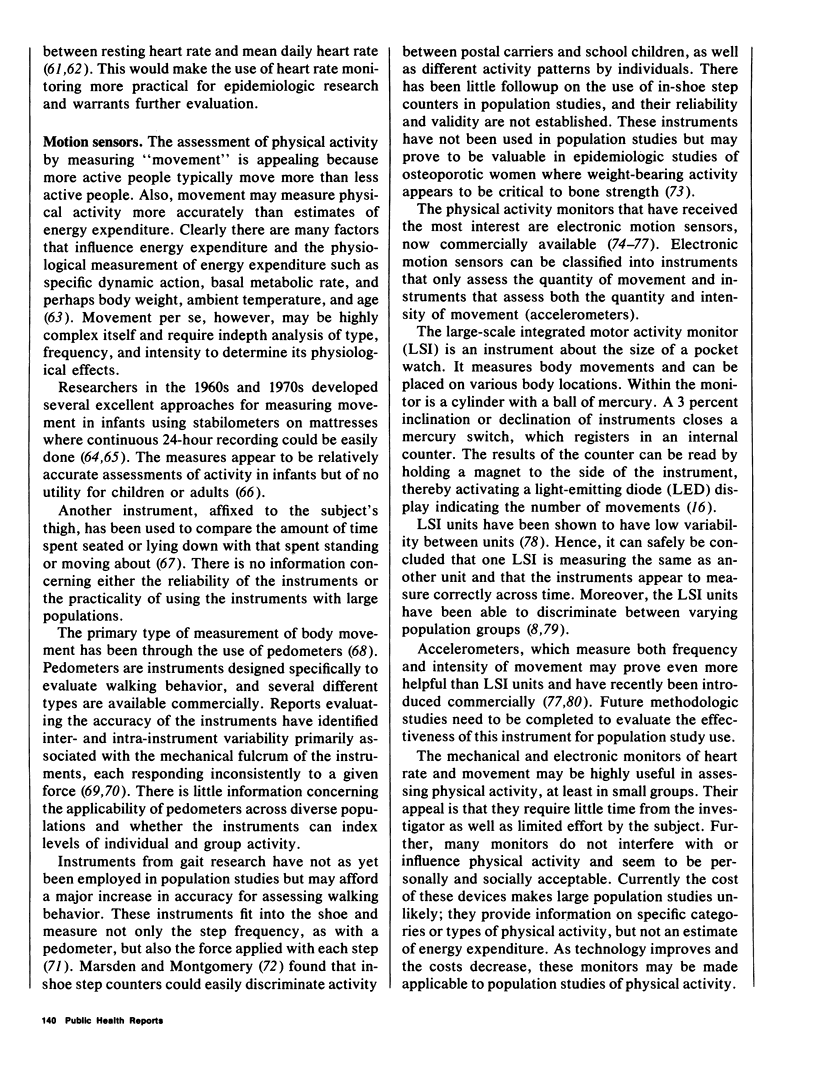
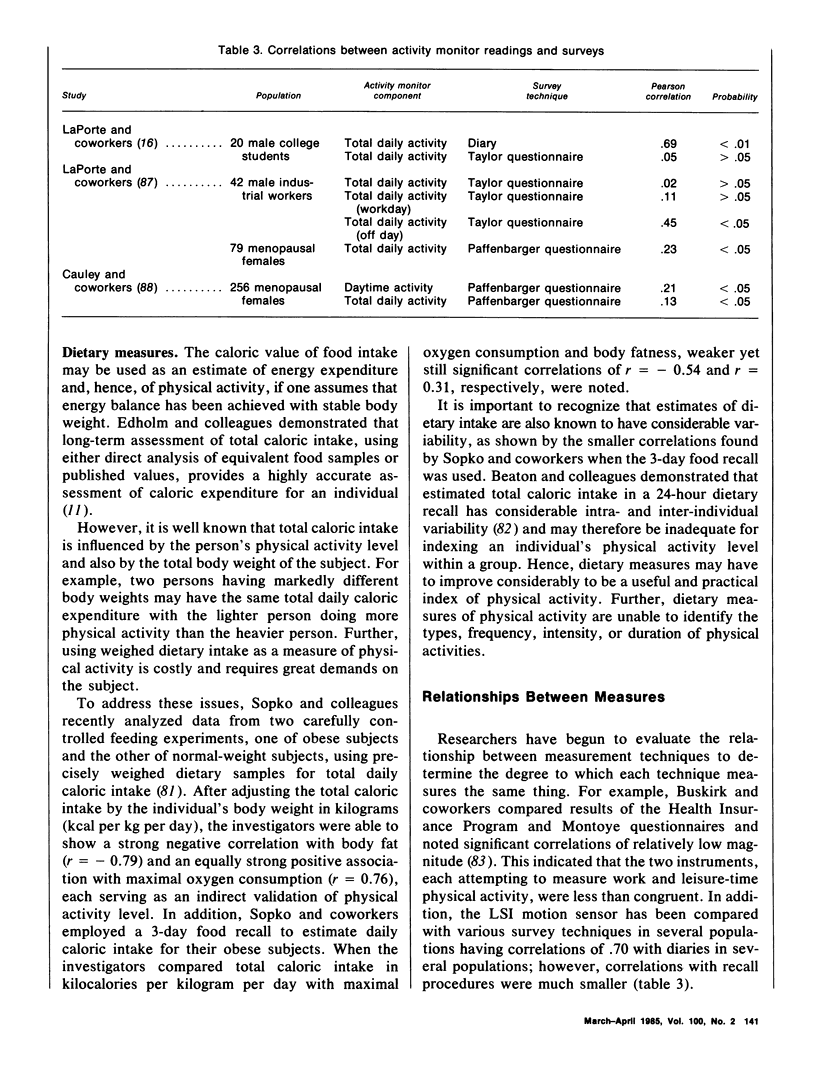
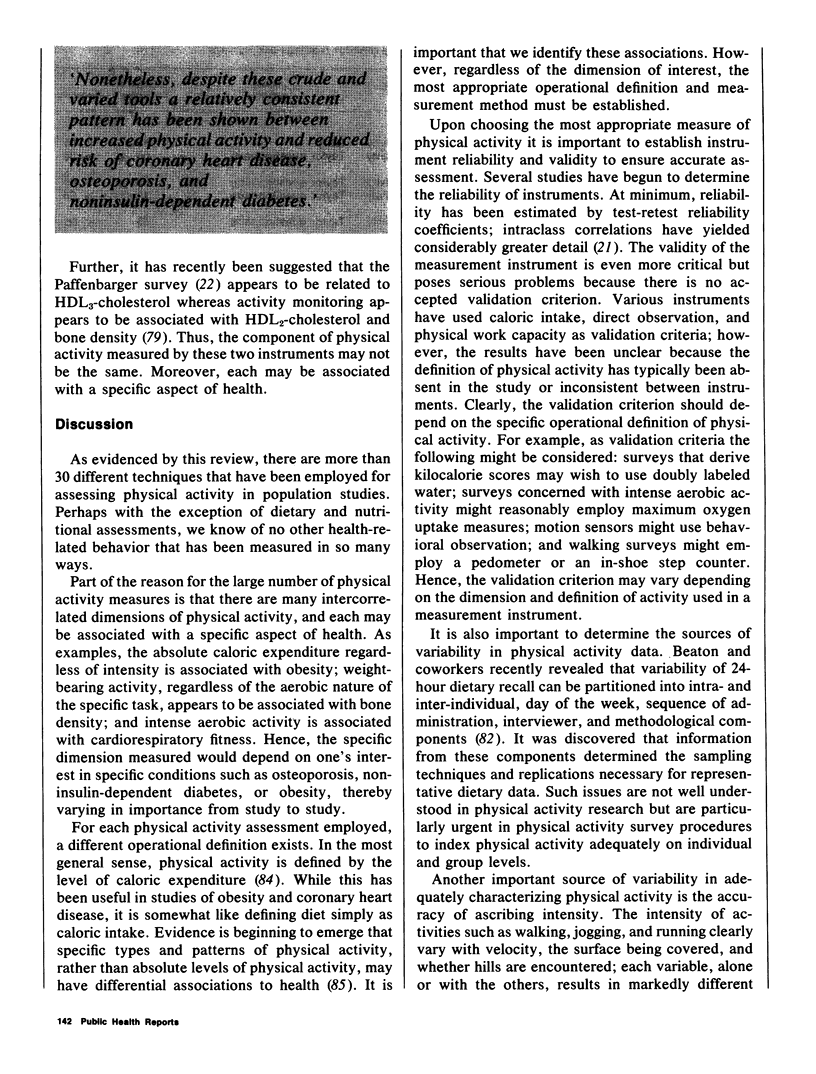
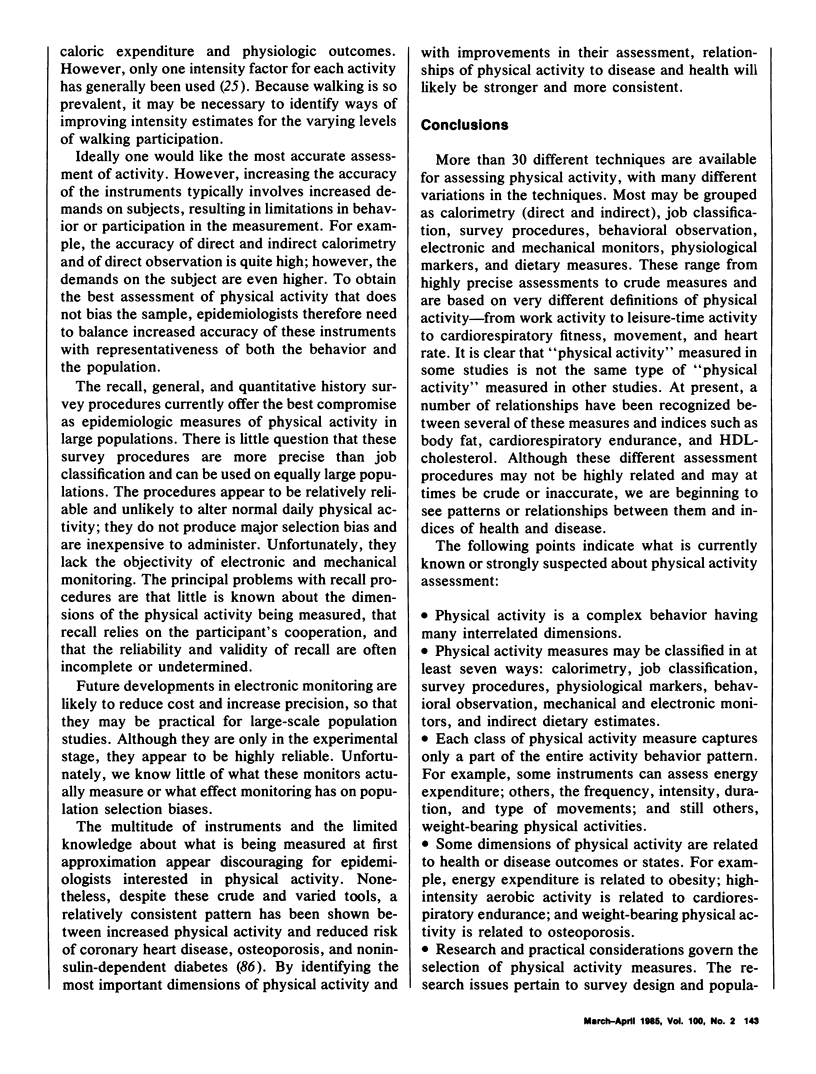
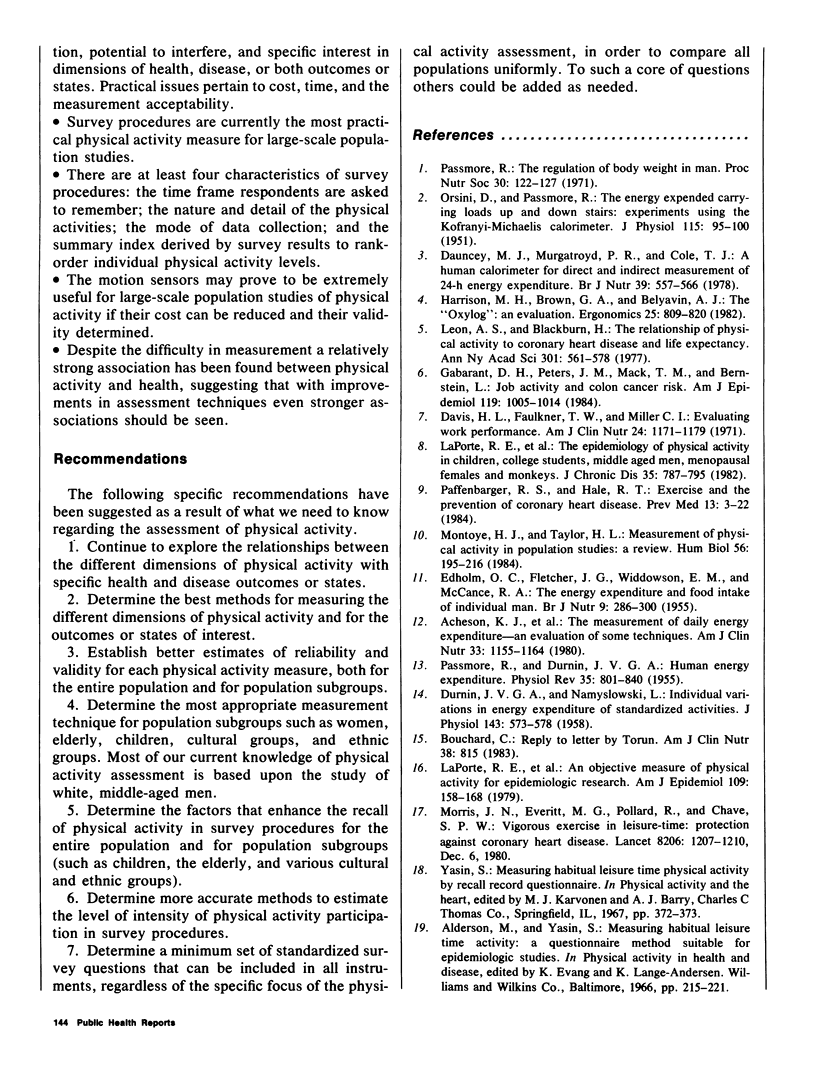
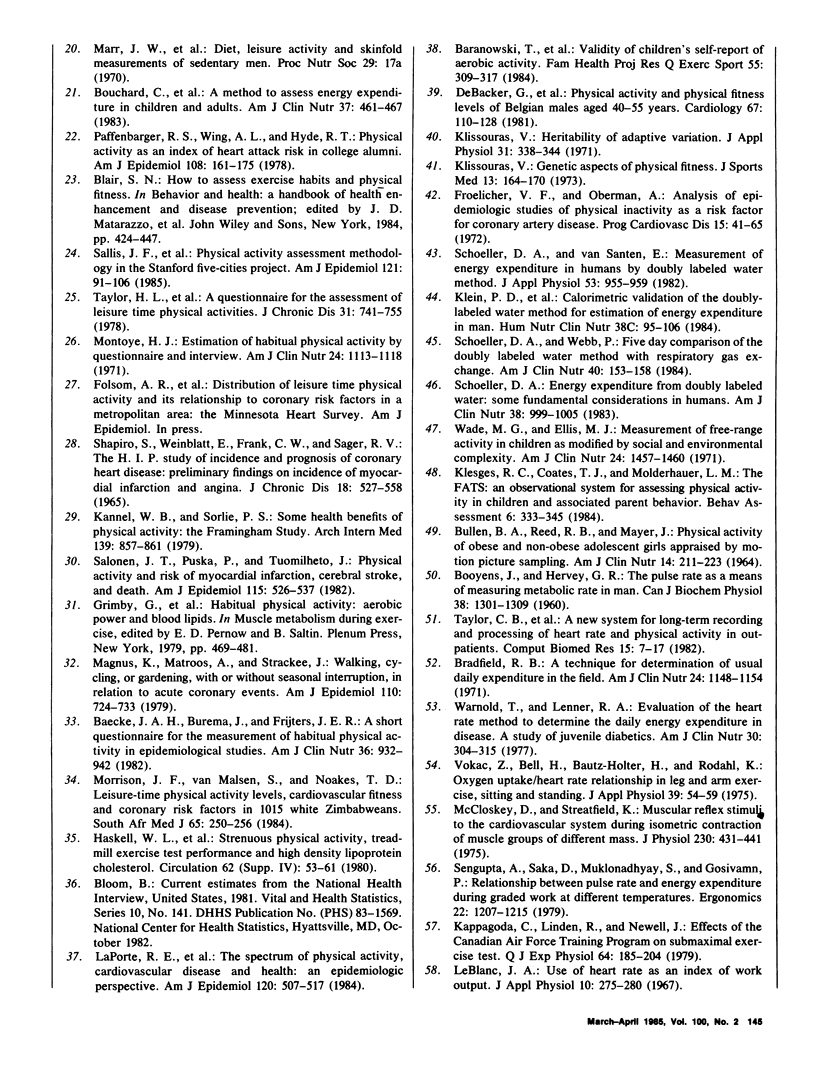
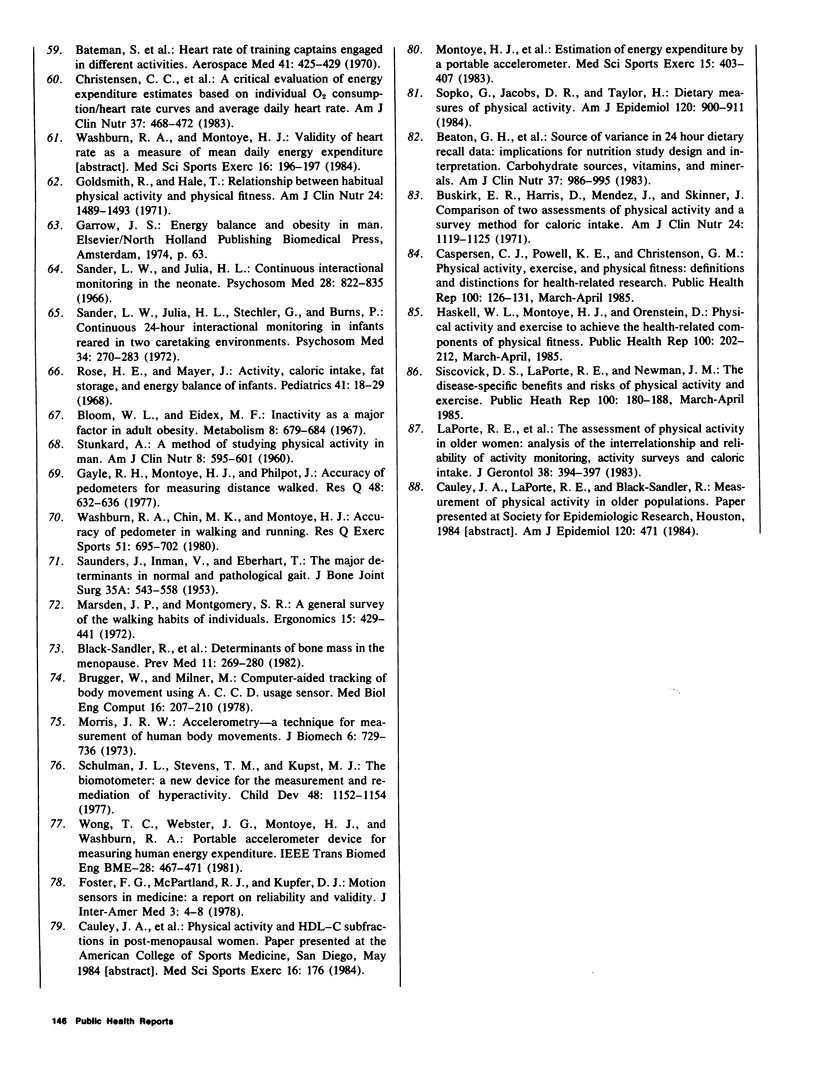
Selected References
These references are in PubMed. This may not be the complete list of references from this article.
- Acheson K. J., Campbell I. T., Edholm O. G., Miller D. S., Stock M. J. The measurement of daily energy expenditure--an evaluation of some techniques. Am J Clin Nutr. 1980 May;33(5):1155–1164. doi: 10.1093/ajcn/33.5.1155. [DOI] [PubMed] [Google Scholar]
- BULLEN B. A., REED R. B., MAYER J. PHYSICAL ACTIVITY OF OBESE AND NONOBESE ADOLESCENT GIRLS APPRAISED BY MOTION PICTURE SAMPLING. Am J Clin Nutr. 1964 Apr;14:211–223. doi: 10.1093/ajcn/14.4.211. [DOI] [PubMed] [Google Scholar]
- Baecke J. A., Burema J., Frijters J. E. A short questionnaire for the measurement of habitual physical activity in epidemiological studies. Am J Clin Nutr. 1982 Nov;36(5):936–942. doi: 10.1093/ajcn/36.5.936. [DOI] [PubMed] [Google Scholar]
- Bateman S. C., Goldsmith R., Jackson K. F., Smith H. P., Mattocks V. S. Heart rate of training captains engaged in different activities. Aerosp Med. 1970 Apr;41(4):425–429. [PubMed] [Google Scholar]
- Beaton G. H., Milner J., McGuire V., Feather T. E., Little J. A. Source of variance in 24-hour dietary recall data: implications for nutrition study design and interpretation. Carbohydrate sources, vitamins, and minerals. Am J Clin Nutr. 1983 Jun;37(6):986–995. doi: 10.1093/ajcn/37.6.986. [DOI] [PubMed] [Google Scholar]
- Black-Sandler R., LaPorte R. E., Sashin D., Kuller L. H., Sternglass E., Cauley J. A., Link M. M. Determinants of bone mass in menopause. Prev Med. 1982 May;11(3):269–280. doi: 10.1016/0091-7435(82)90053-6. [DOI] [PubMed] [Google Scholar]
- Bouchard C., Tremblay A., Leblanc C., Lortie G., Savard R., Thériault G. A method to assess energy expenditure in children and adults. Am J Clin Nutr. 1983 Mar;37(3):461–467. doi: 10.1093/ajcn/37.3.461. [DOI] [PubMed] [Google Scholar]
- Bradfield R. B. A technique for determination of usual daily energy expenditure in the field. Am J Clin Nutr. 1971 Sep;24(9):1148–1154. doi: 10.1093/ajcn/24.9.1148. [DOI] [PubMed] [Google Scholar]
- Brügger W., Milner M. Computer-aided tracking of body motions using a c.c.d.-image sensor. Med Biol Eng Comput. 1978 Mar;16(2):207–210. doi: 10.1007/BF02451923. [DOI] [PubMed] [Google Scholar]
- Buskirk E. R., Harris D., Mendez J., Skinner J. Comparison of two assessments of physical activity and a survey method for calorie intake. Am J Clin Nutr. 1971 Sep;24(9):1119–1125. doi: 10.1093/ajcn/24.9.1119. [DOI] [PubMed] [Google Scholar]
- Caan B., Petitti D. B. Food intake and weight gain in pregnant women. Am J Clin Nutr. 1983 Nov;38(5):815–817. doi: 10.1093/ajcn/38.5.815. [DOI] [PubMed] [Google Scholar]
- Caspersen C. J., Powell K. E., Christenson G. M. Physical activity, exercise, and physical fitness: definitions and distinctions for health-related research. Public Health Rep. 1985 Mar-Apr;100(2):126–131. [PMC free article] [PubMed] [Google Scholar]
- Christensen C. C., Frey H. M., Foenstelien E., Aadland E., Refsum H. E. A critical evaluation of energy expenditure estimates based on individual O2 consumption/heart rate curves and average daily heart rate. Am J Clin Nutr. 1983 Mar;37(3):468–472. doi: 10.1093/ajcn/37.3.468. [DOI] [PubMed] [Google Scholar]
- DURNIN J. V., NAMYSLOWSKI L. Individual variations in the energy expenditure of standardized activities. J Physiol. 1958 Oct 31;143(3):573–578. doi: 10.1113/jphysiol.1958.sp006078. [DOI] [PMC free article] [PubMed] [Google Scholar]
- Dauncey M. J., Murgatroyd P. R., Cole T. J. A human calorimeter for the direct and indirect measurement of 24 h energy expenditure. Br J Nutr. 1978 May;39(3):557–566. doi: 10.1079/bjn19780071. [DOI] [PubMed] [Google Scholar]
- Davis H. L., Faulkner T. W., Miller C. I. Evaluating work performance. Am J Clin Nutr. 1971 Sep;24(9):1171–1179. doi: 10.1093/ajcn/24.9.1171. [DOI] [PubMed] [Google Scholar]
- De Backer G., Kornitzer M., Sobolski J., Dramaix M., Degré S., de Marneffe M., Denolin H. Physical activity and physical fitness levels of Belgian males aged 40-55 years. Cardiology. 1981;67(2):110–128. doi: 10.1159/000173235. [DOI] [PubMed] [Google Scholar]
- EDHOLM O. G., FLETCHER J. G., WIDDOWSON E. M., MCCANCE R. A. The energy expenditure and food intake of individual men. Br J Nutr. 1955;9(3):286–300. doi: 10.1079/bjn19550040. [DOI] [PubMed] [Google Scholar]
- Froelicher V. F., Oberman A. Analysis of epidemiologic studies of physical inactivity as risk factor for coronary artery disease. Prog Cardiovasc Dis. 1972 Jul-Aug;15(1):41–65. doi: 10.1016/0033-0620(72)90004-7. [DOI] [PubMed] [Google Scholar]
- Garabrant D. H., Peters J. M., Mack T. M., Bernstein L. Job activity and colon cancer risk. Am J Epidemiol. 1984 Jun;119(6):1005–1014. doi: 10.1093/oxfordjournals.aje.a113805. [DOI] [PubMed] [Google Scholar]
- Gayle R., Montoye H. J., Philpot J. Accuracy of pedometers for measuring distance walked. Res Q. 1977 Oct;48(3):632–636. [PubMed] [Google Scholar]
- Goldsmith R., Hale T. Relationship between habitual physical activity and physical fitness. Am J Clin Nutr. 1971 Dec;24(12):1489–1493. doi: 10.1093/ajcn/24.12.1489. [DOI] [PubMed] [Google Scholar]
- Harrison M. H., Brown G. A., Belyavin A. J. The 'Oxylog': an evaluation. Ergonomics. 1982 Sep;25(9):809–820. doi: 10.1080/00140138208925037. [DOI] [PubMed] [Google Scholar]
- Haskell W. L., Montoye H. J., Orenstein D. Physical activity and exercise to achieve health-related physical fitness components. Public Health Rep. 1985 Mar-Apr;100(2):202–212. [PMC free article] [PubMed] [Google Scholar]
- Kannel W. B., Sorlie P. Some health benefits of physical activity. The Framingham Study. Arch Intern Med. 1979 Aug;139(8):857–861. [PubMed] [Google Scholar]
- Kappagoda C. T., Linden R. J., Newell J. P. Effect of the Canadian Air Force training programme on a submaximal exercise test. Q J Exp Physiol Cogn Med Sci. 1979 Jul;64(3):185–204. doi: 10.1113/expphysiol.1979.sp002472. [DOI] [PubMed] [Google Scholar]
- Klein P. D., James W. P., Wong W. W., Irving C. S., Murgatroyd P. R., Cabrera M., Dallosso H. M., Klein E. R., Nichols B. L. Calorimetric validation of the doubly-labelled water method for determination of energy expenditure in man. Hum Nutr Clin Nutr. 1984 Mar;38(2):95–106. [PubMed] [Google Scholar]
- Klissouras V. Genetic aspects of physical fitness. J Sports Med Phys Fitness. 1973 Sep;13(3):164–170. [PubMed] [Google Scholar]
- Klissouras V. Heritability of adaptive variation. J Appl Physiol. 1971 Sep;31(3):338–344. doi: 10.1152/jappl.1971.31.3.338. [DOI] [PubMed] [Google Scholar]
- LEBLANC J. A. Use of heart rate as an index of work output. J Appl Physiol. 1957 Mar;10(2):275–280. doi: 10.1152/jappl.1957.10.2.275. [DOI] [PubMed] [Google Scholar]
- LaPorte R. E., Adams L. L., Savage D. D., Brenes G., Dearwater S., Cook T. The spectrum of physical activity, cardiovascular disease and health: an epidemiologic perspective. Am J Epidemiol. 1984 Oct;120(4):507–517. doi: 10.1093/oxfordjournals.aje.a113911. [DOI] [PubMed] [Google Scholar]
- LaPorte R. E., Black-Sandler R., Cauley J. A., Link M., Bayles C., Marks B. The assessment of physical activity in older women: analysis of the interrelationship and reliability of activity monitoring, activity surveys, and caloric intake. J Gerontol. 1983 Jul;38(4):394–397. doi: 10.1093/geronj/38.4.394. [DOI] [PubMed] [Google Scholar]
- LaPorte R. E., Cauley J. A., Kinsey C. M., Corbett W., Robertson R., Black-Sandler R., Kuller L. H., Falkel J. The epidemiology of physical activity in children, college students, middle-aged men, menopausal females and monkeys. J Chronic Dis. 1982;35(10):787–795. doi: 10.1016/0021-9681(82)90090-x. [DOI] [PubMed] [Google Scholar]
- LaPorte R. E., Kuller L. H., Kupfer D. J., McPartland R. J., Matthews G., Caspersen C. An objective measure of physical activity for epidemiologic research. Am J Epidemiol. 1979 Feb;109(2):158–168. doi: 10.1093/oxfordjournals.aje.a112671. [DOI] [PubMed] [Google Scholar]
- Leon A. S., Blackburn H. The relationship of physical activity to coronary heart disease and life expectancy. Ann N Y Acad Sci. 1977;301:561–578. doi: 10.1111/j.1749-6632.1977.tb38230.x. [DOI] [PubMed] [Google Scholar]
- Magnus K., Matroos A., Strackee J. Walking, cycling, or gardening, with or without seasonal interruption, in relation to acute coronary events. Am J Epidemiol. 1979 Dec;110(6):724–733. doi: 10.1093/oxfordjournals.aje.a112853. [DOI] [PubMed] [Google Scholar]
- McCloskey D. I., Streatfeild K. A. Muscular reflex stimuli to the cardiovascular system during isometric contractions of muscle groups of different mass. J Physiol. 1975 Sep;250(2):431–441. doi: 10.1113/jphysiol.1975.sp011063. [DOI] [PMC free article] [PubMed] [Google Scholar]
- Montoye H. J. Estimation of habitual physical activity by questionnaire and interview. Am J Clin Nutr. 1971 Sep;24(9):1113–1118. doi: 10.1093/ajcn/24.9.1113. [DOI] [PubMed] [Google Scholar]
- Montoye H. J., Taylor H. L. Measurement of physical activity in population studies: a review. Hum Biol. 1984 May;56(2):195–216. [PubMed] [Google Scholar]
- Montoye H. J., Washburn R., Servais S., Ertl A., Webster J. G., Nagle F. J. Estimation of energy expenditure by a portable accelerometer. Med Sci Sports Exerc. 1983;15(5):403–407. [PubMed] [Google Scholar]
- Morris J. R. Accelerometry--a technique for the measurement of human body movements. J Biomech. 1973 Nov;6(6):729–736. doi: 10.1016/0021-9290(73)90029-8. [DOI] [PubMed] [Google Scholar]
- Morrison J. F., van Malsen S., Noakes T. D. Leisure-time physical activity levels, cardiovascular fitness and coronary risk factors in 1015 white Zimbabweans. S Afr Med J. 1984 Feb 18;65(7):250–256. [PubMed] [Google Scholar]
- ORSINI D., PASSMORE R. The energy expended carrying loads up and down stairs; experiments using the Kofranyi-Michaelis calorimeter. J Physiol. 1951 Sep;115(1):95–100. doi: 10.1113/jphysiol.1951.sp004654. [DOI] [PMC free article] [PubMed] [Google Scholar]
- PASSMORE R., DURNIN J. V. Human energy expenditure. Physiol Rev. 1955 Oct;35(4):801–840. doi: 10.1152/physrev.1955.35.4.801. [DOI] [PubMed] [Google Scholar]
- Paffenbarger R. S., Jr, Hyde R. T. Exercise in the prevention of coronary heart disease. Prev Med. 1984 Jan;13(1):3–22. doi: 10.1016/0091-7435(84)90037-9. [DOI] [PubMed] [Google Scholar]
- Paffenbarger R. S., Jr, Wing A. L., Hyde R. T. Physical activity as an index of heart attack risk in college alumni. Am J Epidemiol. 1978 Sep;108(3):161–175. doi: 10.1093/oxfordjournals.aje.a112608. [DOI] [PubMed] [Google Scholar]
- Passmore R. The regulation of body-weight in man. Proc Nutr Soc. 1971 Sep;30(2):122–127. doi: 10.1079/pns19710022. [DOI] [PubMed] [Google Scholar]
- Rose H. E., Mayer J. Activity, calorie intake, fat storage, and the energy balance of infants. Pediatrics. 1968 Jan;41(1):18–29. [PubMed] [Google Scholar]
- SAUNDERS J. B., INMAN V. T., EBERHART H. D. The major determinants in normal and pathological gait. J Bone Joint Surg Am. 1953 Jul;35-A(3):543–558. [PubMed] [Google Scholar]
- Sallis J. F., Haskell W. L., Wood P. D., Fortmann S. P., Rogers T., Blair S. N., Paffenbarger R. S., Jr Physical activity assessment methodology in the Five-City Project. Am J Epidemiol. 1985 Jan;121(1):91–106. doi: 10.1093/oxfordjournals.aje.a113987. [DOI] [PubMed] [Google Scholar]
- Salonen J. T., Puska P., Tuomilehto J. Physical activity and risk of myocardial infarction, cerebral stroke and death: a longitudinal study in Eastern Finland. Am J Epidemiol. 1982 Apr;115(4):526–537. doi: 10.1093/oxfordjournals.aje.a113334. [DOI] [PubMed] [Google Scholar]
- Sander L. W., Julia H. L. Continuous interactional monitoring in the neonate. Psychosom Med. 1966 Nov-Dec;28(6):822–835. doi: 10.1097/00006842-196611000-00005. [DOI] [PubMed] [Google Scholar]
- Sander L. W., Julia H. L., Stechler G., Burns P. Continuous 24-hour interactional monitoring in infants reared in two caretaking environments. Psychosom Med. 1972 May-Jun;34(3):270–282. doi: 10.1097/00006842-197205000-00009. [DOI] [PubMed] [Google Scholar]
- Schoeller D. A. Energy expenditure from doubly labeled water: some fundamental considerations in humans. Am J Clin Nutr. 1983 Dec;38(6):999–1005. doi: 10.1093/ajcn/38.6.999. [DOI] [PubMed] [Google Scholar]
- Schoeller D. A., Webb P. Five-day comparison of the doubly labeled water method with respiratory gas exchange. Am J Clin Nutr. 1984 Jul;40(1):153–158. doi: 10.1093/ajcn/40.1.153. [DOI] [PubMed] [Google Scholar]
- Schoeller D. A., van Santen E. Measurement of energy expenditure in humans by doubly labeled water method. J Appl Physiol Respir Environ Exerc Physiol. 1982 Oct;53(4):955–959. doi: 10.1152/jappl.1982.53.4.955. [DOI] [PubMed] [Google Scholar]
- Sengupta A. K., Sarkar D. N., Mukhopadhyay S., Goswami D. C. Relationship between pulse rate and energy expenditure during graded work at different temperatures. Ergonomics. 1979 Nov;22(11):1207–1215. doi: 10.1080/00140137908924695. [DOI] [PubMed] [Google Scholar]
- Siscovick D. S., LaPorte R. E., Newman J. M. The disease-specific benefits and risks of physical activity and exercise. Public Health Rep. 1985 Mar-Apr;100(2):180–188. [PMC free article] [PubMed] [Google Scholar]
- Sopko G., Jacobs D. R., Jr, Taylor H. L. Dietary measures of physical activity. Am J Epidemiol. 1984 Dec;120(6):900–911. doi: 10.1093/oxfordjournals.aje.a113961. [DOI] [PubMed] [Google Scholar]
- Taylor C. B., Kraemer H. C., Bragg D. A., Miles L. E., Rule B., Savin W. M., DeBusk R. F. A new system for long-term recording and processing of heart rate and physical activity in outpatients. Comput Biomed Res. 1982 Feb;15(1):7–17. doi: 10.1016/0010-4809(82)90048-9. [DOI] [PubMed] [Google Scholar]
- Taylor H. L., Jacobs D. R., Jr, Schucker B., Knudsen J., Leon A. S., Debacker G. A questionnaire for the assessment of leisure time physical activities. J Chronic Dis. 1978;31(12):741–755. doi: 10.1016/0021-9681(78)90058-9. [DOI] [PubMed] [Google Scholar]
- Vokac Z., Bell H., Bautz-Holter E., Rodahl K. Oxygen uptake/heart rate relationship in leg and arm exercise, sitting and standing. J Appl Physiol. 1975 Jul;39(1):54–59. doi: 10.1152/jappl.1975.39.1.54. [DOI] [PubMed] [Google Scholar]
- Wade M. G., Ellis M. J. Measurement of free-range activity in children as modified by social and environmental complexity. Am J Clin Nutr. 1971 Dec;24(12):1457–1460. doi: 10.1093/ajcn/24.12.1457. [DOI] [PubMed] [Google Scholar]
- Warnold I., Lenner R. A. Evaluation of the heart rate method to determine the daily energy expenditure in disease. A study in juvenile diabetics. Am J Clin Nutr. 1977 Mar;30(3):304–315. doi: 10.1093/ajcn/30.3.304. [DOI] [PubMed] [Google Scholar]
- Washburn R., Chin M. K., Montoye H. J. Accuracy of pedometer in walking and running. Res Q Exerc Sport. 1980 Dec;51(4):695–702. doi: 10.1080/02701367.1980.10609330. [DOI] [PubMed] [Google Scholar]
- Wong T. C., Webster J. G., Montoye H. J., Washburn R. Portable accelerometer device for measuring human energy expenditure. IEEE Trans Biomed Eng. 1981 Jun;28(6):467–471. doi: 10.1109/TBME.1981.324820. [DOI] [PubMed] [Google Scholar]


